Antifungal Effect of Polymethyl Methacrylate Resin Base with Embedded Au Nanoparticles
Abstract
1. Introduction
2. Materials and Methods
2.1. Materials
2.1.1. Preparation of Au Nanoparticles
2.1.2. Preparation of PMMA and PMMA/Au Films
2.1.3. Fungi/Yeast
2.2. Methods
2.2.1. UV-Vis Spectroscopy
2.2.2. CIE Colorimetry
2.2.3. Contact Angle Measurements
2.2.4. Zeta Potential Measurements
2.2.5. Surface Morphology and Topography
2.2.6. Mechanical Properties
2.2.7. Cell Adhesion
2.2.8. SEM Analysis and EDS Analysis
3. Results
3.1. UV-Vis Spectroscopy
3.2. CIE Colorimetry
3.3. Contact Angle Measurement Results
3.4. Streaming Potential Results
3.5. Surface Roughness
3.6. Mechanical Properties
3.7. Evaluation of Adhesion Extent of C. albicans
3.8. EDS Analysis
4. Discussion
5. Conclusions
- The addition of Au NPs decreases the tensile strength and slightly increases the hardness of the base PMMA material.
- The addition of Au NPs does not significantly affect the color of the base material, but does affect its wettability, surface charge, and roughness.
- The addition of Au NPs improves the resistance of the base material to the adhesion of C. albicans by 66% after 24 h and by 43% after 48 h.
Author Contributions
Funding
Data Availability Statement
Conflicts of Interest
References
- United Nations Department of Economic and Social Affairs Population Division. World Population Ageing; United Nations Department of Economic and Social Affairs Population Division: New York, NY, USA, 2019. [Google Scholar]
- Gendreau, L.; Loewy, Z.G. Epidemiology and Etiology of Denture Stomatitis. J. Prosthodont. 2011, 20, 251–260. [Google Scholar] [CrossRef]
- Perić, M.; Živković, R.; Milić Lemić, A.; Radunović, M.; Miličić, B.; Arsić Arsenijević, V. The Severity of Denture Stomatitis as Related to Risk Factors and Different Candida spp. Oral Surg. Oral Med. Oral Pathol. Oral Radiol. 2018, 126, 41–47. [Google Scholar] [CrossRef]
- Jiang, C.M.; Chu, C.H.; Duangthip, D.; Ettinger, R.L.; Hugo, F.N.; Kettratad-Pruksapong, M.; Liu, J.; Marchini, L.; McKenna, G.; Ono, T.; et al. Global Perspectives of Oral Health Policies and Oral Healthcare Schemes for Older Adult Populations. Front. Oral Health 2021, 2, 703526. [Google Scholar] [CrossRef] [PubMed]
- Sartawi, S.Y.; Abu-Hammad, S.; Salim, N.A.; Al-Omoush, S. Denture Stomatitis Revisited: A Summary of Systematic Reviews in the Past Decade and Two Case Reports of Papillary Hyperplasia of Unusual Locations. Int. J. Dent. 2021, 2021, 7338143. [Google Scholar] [CrossRef]
- Muhvić-Urek, M.; Saltović, E.; Braut, A.; Kovačević Pavičić, D. Association between Vitamin D and Candida-Associated Denture Stomatitis. Dent. J. 2020, 8, 121. [Google Scholar] [CrossRef]
- Alzayer, Y.M.; Gomez, G.F.; Eckert, G.J.; Levon, J.A.; Gregory, R.L. The Impact of Nicotine and Cigarette Smoke Condensate on Metabolic Activity and Biofilm Formation of Candida albicans on Acrylic Denture Material. J. Prosthodont. 2020, 29, 173–178. [Google Scholar] [CrossRef]
- Gual-Vaques, P.; Jane-Salas, E.; Egido-Moreno, S.; Ayuso-Montero, R.; Mari-Roig, A.; Lopez-Lopez, J. Inflammatory Papillary Hyperplasia: A Systematic Review. Med. Oral Patol. Oral Cir. Bucal 2016, 22, e36. [Google Scholar] [CrossRef] [PubMed]
- Sampaio-Maia, B.; Figueiral, M.H.; Sousa-Rodrigues, P.; Fernandes, M.H.; Scully, C. The Effect of Denture Adhesives on Candida albicans Growth In Vitro. Gerodontology 2012, 29, e348–e356. [Google Scholar] [CrossRef] [PubMed]
- Zafar, M.S. Prosthodontic Applications of Polymethyl Methacrylate (PMMA): An Update. Polymers 2020, 12, 2299. [Google Scholar] [CrossRef]
- Adamović, T.; Veselinović, V.; Trtić, N.; Hadži-Mihailović, M.; Gotovac Atlagić, S.; Balaban, M.; Hattori, Y.; Sugiyama, H.; Ivanič, A.; Rudolf, R. Mechanical Properties of New Denture Base Material Modified with Gold Nanoparticles. J. Prosthodont. Res. 2021, 65, 155–161. [Google Scholar] [CrossRef]
- de Castro, D.T.; Valente, M.L.C.; Agnelli, J.A.M.; Lovato da Silva, C.H.; Watanabe, E.; Siqueira, R.L.; Alves, O.L.; Holtz, R.D.; dos Reis, A.C. In Vitro Study of the Antibacterial Properties and Impact Strength of Dental Acrylic Resins Modified with a Nanomaterial. J. Prosthet. Dent. 2016, 115, 238–246. [Google Scholar] [CrossRef]
- Zore, A.; Abram, A.; Učakar, A.; Godina, I.; Rojko, F.; Štukelj, R.; Škapin, A.S.; Vidrih, R.; Dolic, O.; Veselinovic, V.; et al. Antibacterial Effect of Polymethyl Methacrylate Resin Base Containing TiO2 Nanoparticles. Coatings 2022, 12, 1757. [Google Scholar] [CrossRef]
- Ajaj-ALKordy, N.M.; Alsaadi, M.H. Elastic Modulus and Flexural Strength Comparisons of High-Impact and Traditional Denture Base Acrylic Resins. Saudi Dent. J. 2014, 26, 15–18. [Google Scholar] [CrossRef]
- Kumar, A.; Seenivasan, M.K.; Inbarajan, A. A literature review on biofilm formation on silicone and poymethyl methacrylate used for maxillofacial prostheses. Cureus 2021, 13, e20029. [Google Scholar] [CrossRef]
- Mukherjee, P.K.; Zhou, G.; Munyon, R.; Ghannoum, M.A. Candida Biofilm: A Well-Designed Protected Environment. Med. Mycol. 2005, 43, 191–208. [Google Scholar] [CrossRef]
- Hall-Stoodley, L.; Costerton, J.W.; Stoodley, P. Bacterial Biofilms: From the Natural Environment to Infectious Diseases. Nat. Rev. Microbiol. 2004, 2, 95–108. [Google Scholar] [CrossRef] [PubMed]
- Brown, L.; Wolf, J.M.; Prados-Rosales, R.; Casadevall, A. Through the Wall: Extracellular Vesicles in Gram-Positive Bacteria, Mycobacteria and Fungi. Nat. Rev. Microbiol. 2015, 13, 620–630. [Google Scholar] [CrossRef]
- Juan, T.; Fürthauer, M. Biogenesis and Function of ESCRT-Dependent Extracellular Vesicles. Semin. Cell Dev. Biol. 2018, 74, 66–77. [Google Scholar] [CrossRef]
- Zarnowski, R.; Sanchez, H.; Covelli, A.S.; Dominguez, E.; Jaromin, A.; Bernhardt, J.; Mitchell, K.F.; Heiss, C.; Azadi, P.; Mitchell, A.; et al. Candida albicans Biofilm–Induced Vesicles Confer Drug Resistance through Matrix Biogenesis. PLoS Biol. 2018, 16, e2006872. [Google Scholar] [CrossRef] [PubMed]
- Public Health England. What Is Known about the Oral Health of Older People in England and Wales—A Review of Oral Health Surveys of Older People; Public Health England: London, UK, 2015. [Google Scholar]
- Janbon, G.; Quintin, J.; Lanternier, F.; d’Enfert, C. Studying Fungal Pathogens of Humans and Fungal Infections: Fungal Diversity and Diversity of Approaches. Microbes Infect. 2019, 21, 237–245. [Google Scholar] [CrossRef] [PubMed]
- Statista Research Department. U.S. Population: Do You Use Dentures? Usage of dentures in U.S. in 2020. Available online: https://www.statista.com/statistics/275484/us-households-usage-of-dentures/ (accessed on 5 May 2023).
- Redfern, J.; Tosheva, L.; Malic, S.; Butcher, M.; Ramage, G.; Verran, J. The Denture Microbiome in Health and Disease: An Exploration of a Unique Community. Lett. Appl. Microbiol. 2022, 75, 195–209. [Google Scholar] [CrossRef]
- Song, F.; Koo, H.; Ren, D. Effects of Material Properties on Bacterial Adhesion and Biofilm Formation. J. Dent. Res. 2015, 94, 1027–1034. [Google Scholar] [CrossRef] [PubMed]
- Mayahara, M.; Kataoka, R.; Arimoto, T.; Tamaki, Y.; Yamaguchi, N.; Watanabe, Y.; Yamasaki, Y.; Miyazaki, T. Effects of Surface Roughness and Dimorphism on the Adhesion of Candida albicans to the Surface of Resins: Scanning Electron Microscope Analyses of Mode and Number of Adhesions. J. Investig. Clin. Dent. 2014, 5, 307–312. [Google Scholar] [CrossRef]
- Bohinc, K.; Tintor, E.; Kovačević, D.; Vidrih, R.; Zore, A.; Abram, A.; Kojić, Ž.; Obradović, M.; Veselinović, V.; Dolić, O. Bacterial Adhesion on Glass–Ionomer Cements and Micro/Nano Hybrid Composite Dental Surfaces. Coatings 2021, 11, 235. [Google Scholar] [CrossRef]
- Bohinc, K.; Dražić, G.; Abram, A.; Jevšnik, M.; Jeršek, B.; Nipič, D.; Kurinčič, M.; Raspor, P. Metal Surface Characteristics Dictate Bacterial Adhesion Capacity. Int. J. Adhes. Adhes. 2016, 68, 39–46. [Google Scholar] [CrossRef]
- Ivanov, M.; Ćirić, A.; Stojković, D. Emerging Antifungal Targets and Strategies. Int. J. Mol. Sci. 2022, 23, 2756. [Google Scholar] [CrossRef] [PubMed]
- McEwen, S.A.; Collignon, P.J. Antimicrobial Resistance: A One Health Perspective. Microbiol. Spectr. 2018, 6, 521–547. [Google Scholar] [CrossRef]
- Gad, M.; Fouda, S. Current Perspectives and the Future of Candida albicans-Associated Denture Stomatitis Treatment. Dent. Med. Probl. 2020, 57, 95–102. [Google Scholar] [CrossRef]
- Gad, M.; Fouda, S.; Al-Harbi, F.; Näpänkangas, R.; Raustia, A. PMMA Denture Base Material Enhancement: A Review of Fiber, Filler, and Nanofiller Addition. Int. J. Nanomed. 2017, 12, 3801–3812. [Google Scholar] [CrossRef]
- Hamedi-Rad, F.; Ghaffari, T.; Rezaii, F.; Ramazani, A. Effect of Nanosilver on Thermal and Mechanical Properties of Acrylic Base Complete Dentures. J. Dent. 2014, 11, 495. [Google Scholar]
- Gad, M.M.; Al-Thobity, A.M.; Rahoma, A.; Abualsaud, R.; Al-Harbi, F.A.; Akhtar, S. Reinforcement of PMMA Denture Base Material with a Mixture of ZrO2 Nanoparticles and Glass Fibers. Int. J. Dent. 2019, 2019, 2489393. [Google Scholar] [CrossRef]
- Wang, R.; Tao, J.; Yu, B.; Dai, L. Characterization of Multiwalled Carbon Nanotube-Polymethyl Methacrylate Composite Resins as Denture Base Materials. J. Prosthet. Dent. 2014, 3, 318–326. [Google Scholar] [CrossRef]
- Petrochenko, P.E.; Zheng, J.; Casey, B.J.; Bayati, M.R.; Narayan, R.J.; Goering, P.L. Nanosilver-PMMA Composite Coating Optimized to Provide Robust Antibacterial Efficacy While Minimizing Human Bone Marrow Stromal Cell Toxicity. Toxicol. Vitr. 2017, 44, 248–255. [Google Scholar] [CrossRef]
- Yin, I.X.; Zhang, J.; Zhao, I.S.; Mei, M.L.; Li, Q.; Chu, C.H. The Antibacterial Mechanism of Silver Nanoparticles and Its Application in Dentistry. Int. J. Nanomed. 2020, 15, 2555–2562. [Google Scholar] [CrossRef]
- Akhavan, A.; Sheikh, N.; Beteshobabrud, R. Polymethylmethacrylate/Silver Nanocomposite Prepared by γ-Ray. J. Nucl. Sci. Technol. 2010, 50, 80–84. [Google Scholar]
- Kalimuthu, K.; Cha, B.S.; Kim, S.; Park, K.S. Eco-Friendly Synthesis and Biomedical Applications of Gold Nanoparticles: A Review. Microchem. J. 2020, 152, 104296. [Google Scholar] [CrossRef]
- Turkevich, J.; Stevenson, P.C.; Hillier, J. A Study of the Nucleation and Growth Processes in the Synthesis of Colloidal Gold. Discuss. Faraday Soc. 1951, 11, 55. [Google Scholar] [CrossRef]
- Yilmaz, E.; Suzer, S. Au Nanoparticles in PMMA Matrix: In Situ Synthesis and the Effect of Au Nanoparticles on PMMA Conductivity. Appl. Surf. Sci. 2010, 256, 6630–6633. [Google Scholar] [CrossRef]
- Majerič, P.; Rudolf, R. Advances in Ultrasonic Spray Pyrolysis Processing of Noble Metal Nanoparticles—Review. Materials 2020, 13, 3485. [Google Scholar] [CrossRef]
- Rudolf, R.; Shariq, M.; Veselinovic, V.; Adamovic, T.; Bobovnik, R.; Kargl, R.; Majeric, P. Synthesis of Gold Nanoparticles Through Ultrasonic Spray Pyrolysis and Its Application in Printed Electronics. Contemp. Mater. 2018, 9, 106–112. [Google Scholar] [CrossRef]
- Marić, I.; Gotić, M.; Pustak, A.; Dražić, G.; Grenèche, J.-M.; Jurkin, T. Magnetic δ-FeOOH/Au Nanostructures Synthesized Using γ-Irradiation Method and Their Catalytic Activity for the Reduction of 4-Nitrophenol. Appl. Surf. Sci. 2023, 611, 155653. [Google Scholar] [CrossRef]
- Schulz, F.; Homolka, T.; Bastús, N.G.; Puntes, V.; Weller, H.; Vossmeyer, T. Little Adjustments Significantly Improve the Turkevich Synthesis of Gold Nanoparticles. Langmuir 2014, 30, 10779–10784. [Google Scholar] [CrossRef]
- Adamović, T.; Veselinović, V.; Trtić, N.; Janković, O.; Mirjanić, V.; Umićević Davidović, M.; Rudolf, R. Color Properties of Polymethylmethacrylate Material Incorporated With Gold Nanoparticles. Contemp. Mater. 2021, 13, 102–110. [Google Scholar] [CrossRef]
- Qiu, L.; Zou, H.; Wang, X.; Feng, Y.; Zhang, X.; Zhao, J.; Zhang, X.; Li, Q. Enhancing the Interfacial Interaction of Carbon Nanotubes Fibers by Au Nanoparticles with Improved Performance of the Electrical and Thermal Conductivity. Carbon N. Y. 2019, 141, 497–505. [Google Scholar] [CrossRef]
- Sawant, S.N.; Selvaraj, V.; Prabhawathi, V.; Doble, M. Antibiofilm Properties of Silver and Gold Incorporated PU, PCLm, PC and PMMA Nanocomposites under Two Shear Conditions. PLoS ONE 2013, 8, e63311. [Google Scholar] [CrossRef]
- Jebali, A.; Hajjar, F.H.E.; Pourdanesh, F.; Hekmatimoghaddam, S.; Kazemi, B.; Masoudi, A.; Daliri, K.; Sedighi, N. Silver and Gold Nanostructures: Antifungal Property of Different Shapes of These Nanostructures on Candida Species. Med. Mycol. 2014, 52, 65–72. [Google Scholar] [CrossRef] [PubMed]
- Peña-González, C.E.; Pedziwiatr-Werbicka, E.; Martín-Pérez, T.; Szewczyk, E.M.; Copa-Patiño, J.L.; Soliveri, J.; Pérez-Serrano, J.; Gómez, R.; Bryszewska, M.; Sánchez-Nieves, J.; et al. Antibacterial and Antifungal Properties of Dendronized Silver and Gold Nanoparticles with Cationic Carbosilane Dendrons. Int. J. Pharm. 2017, 528, 55–61. [Google Scholar] [CrossRef]
- Ahmad, T.; Wani, I.A.; Lone, I.H.; Ganguly, A.; Manzoor, N.; Ahmad, A.; Ahmed, J.; Al-Shihri, A.S. Antifungal Activity of Gold Nanoparticles Prepared by Solvothermal Method. Mater. Res. Bull. 2013, 48, 12–20. [Google Scholar] [CrossRef]
- Russo, T.; Gloria, A.; De Santis, R.; D’Amora, U.; Balato, G.; Vollaro, A.; Oliviero, O.; Improta, G.; Triassi, M.; Ambrosio, L. Preliminary Focus on the Mechanical and Antibacterial Activity of a PMMA-Based Bone Cement Loaded with Gold Nanoparticles. Bioact. Mater. 2017, 2, 156–161. [Google Scholar] [CrossRef]
- Haiss, W.; Thanh, N.T.K.; Aveyard, J.; Fernig, D.G. Determination of Size and Concentration of Gold Nanoparticles from UV-Vis Spectra. Anal. Chem. 2007, 79, 4215–4221. [Google Scholar] [CrossRef] [PubMed]
- Hanžić, N.; Jurkin, T.; Maksimović, A.; Gotić, M. The Synthesis of Gold Nanoparticles by a Citrate-Radiolytical Method. Radiat. Phys. Chem. 2015, 106, 77–82. [Google Scholar] [CrossRef]
- Deák, Á.; Janovák, L.; Tallósy, S.P.; Godič-Torkar, K.; Abram, A.; Dékány, I.; Sebők, D.; Bohinc, K. Synthesis of Self-Cleaning and Photoreactive Spherical Layered Double Oxide/Polymer Composite Thin Layers: Biofouling and Inactivation of Bacteria. Appl. Clay Sci. 2022, 228, 106587. [Google Scholar] [CrossRef]
- Ho, D.K.; Ghinea, R.; Herrera, L.J.; Angelov, N.; Paravina, R.D. Color Range and Color Distribution of Healthy Human Gingiva: A Prospective Clinical Study. Sci. Rep. 2015, 5, 18498. [Google Scholar] [CrossRef] [PubMed]
- Goiato, M.C.; Andreotti, A.M.; Moreno, A.; Nóbrega, A.S.; Pesqueira, A.A.; dos Santos, D.M. Influence of Nanoparticles on Color Stability, Microhardness, and Flexural Strength of Acrylic Resins Specific for Ocular Prosthesis. Int. J. Nanomed. 2014, 9, 5779. [Google Scholar] [CrossRef] [PubMed]
- Kasraei, S.; Azarsina, M. Addition of Silver Nanoparticles Reduces the Wettability of Methacrylate and Silorane-Based Composites. Braz. Oral Res. 2012, 26, 505–515. [Google Scholar] [CrossRef]
- Cascione, M.; De Matteis, V.; Pellegrino, P.; Albanese, G.; De Giorgi, M.L.; Paladini, F.; Corsalini, M.; Rinaldi, R. Improvement of Pmma Dental Matrix Performance by Addition of Titanium Dioxide Nanoparticles and Clay Nanotubes. Nanomaterials 2021, 11, 2027. [Google Scholar] [CrossRef]
- Goswami, R.R.; Pohare, S.D.; Raut, J.S.; Karuppayil, S.M. Cell Surface Hydrophobicity as a Virulence Factor in Candida albicans. Biosci. Biotechnol. Res. Asia 2017, 14, 1503–1511. [Google Scholar] [CrossRef]
- Collins, Y.E.; Stotzky, G. Heavy Metals Alter the Electrokinetic Properties of Bacteria, Yeasts, and Clay Minerals. Appl. Environ. Microbiol. 1992, 58, 1592–1600. [Google Scholar] [CrossRef]
- Chang, H.; Ikram, A.; Kosari, F.; Vasmatzis, G.; Bhunia, A.; Bashir, R. Electrical Characterization of Micro-Organisms Using Microfabricated Devices. J. Vac. Sci. Technol. B Microelectron. Nanometer Struct. 2002, 20, 2058. [Google Scholar] [CrossRef]
- Onwubu, S.C.; Vahed, A.; Singh, S.; Kanny, K.M. Reducing the Surface Roughness of Dental Acrylic Resins by Using an Eggshell Abrasive Material. J. Prosthet. Dent. 2017, 117, 310–314. [Google Scholar] [CrossRef]
- Gungor, H.; Gundogdu, M.; Duymus, Z.Y. Investigation of the Effect of Different Polishing Techniques on the Surface Roughness of Denture Base and Repair Materials Clinical Implications. J. Prosthet. Dent. 2014, 112, 1271–1277. [Google Scholar] [CrossRef] [PubMed]
- Elshereksi, N.W.; Ghazali, M.J.; Muchtar, A.; Azhari, C.H. Investigation on the Physical Properties of Denture Base Resin Filled with Nano-Barium Titanate. Aust. J. Basic Appl. Sci. 2016, 10, 249–257. [Google Scholar]

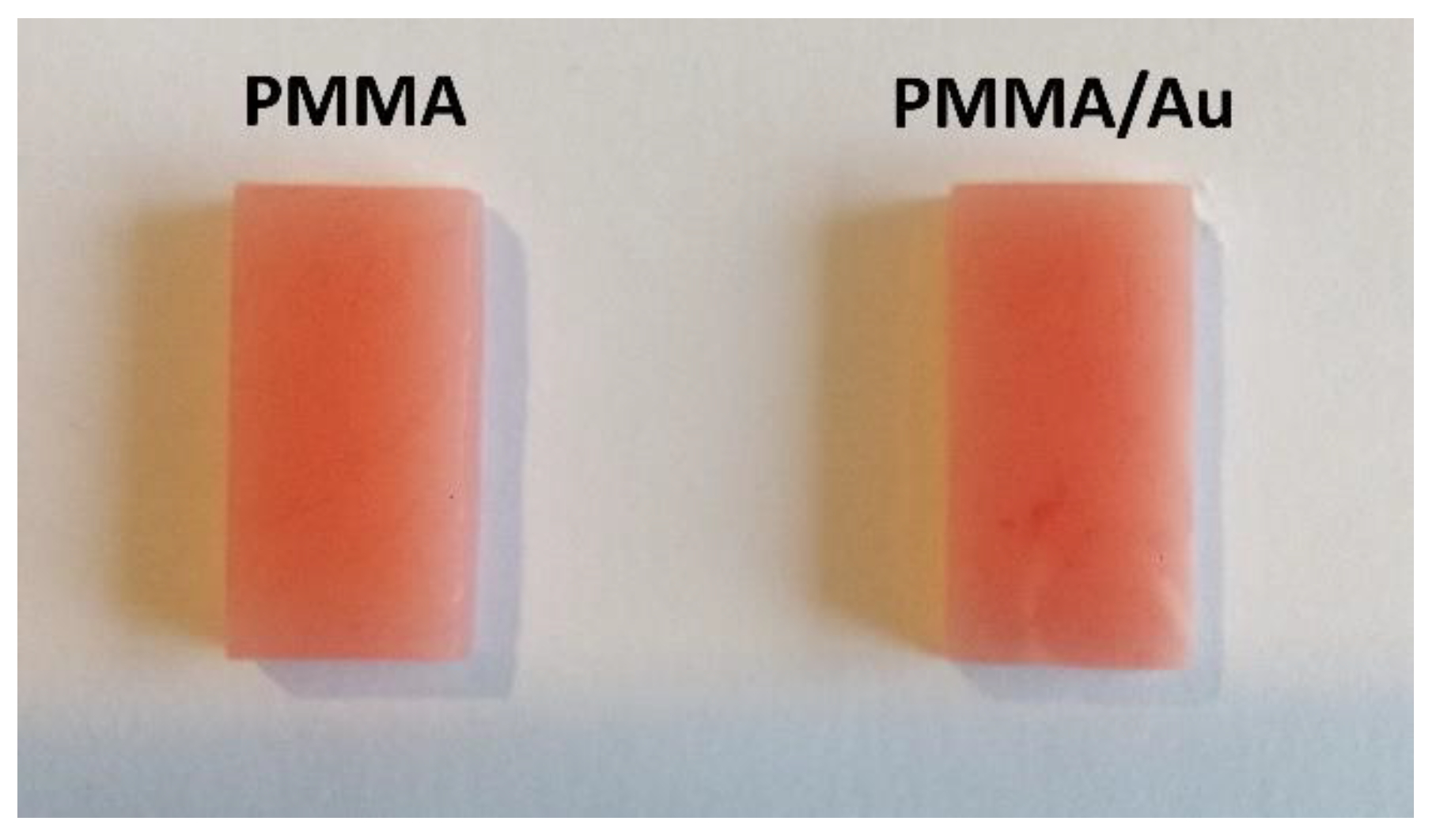
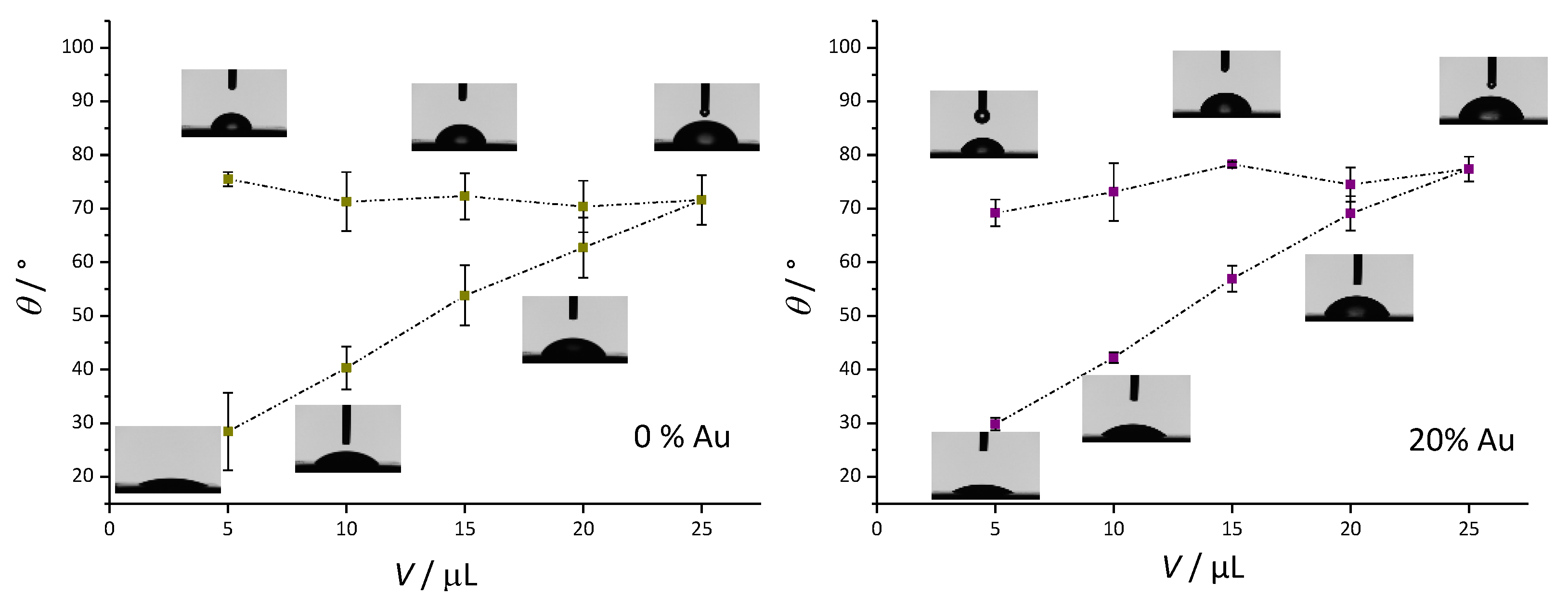
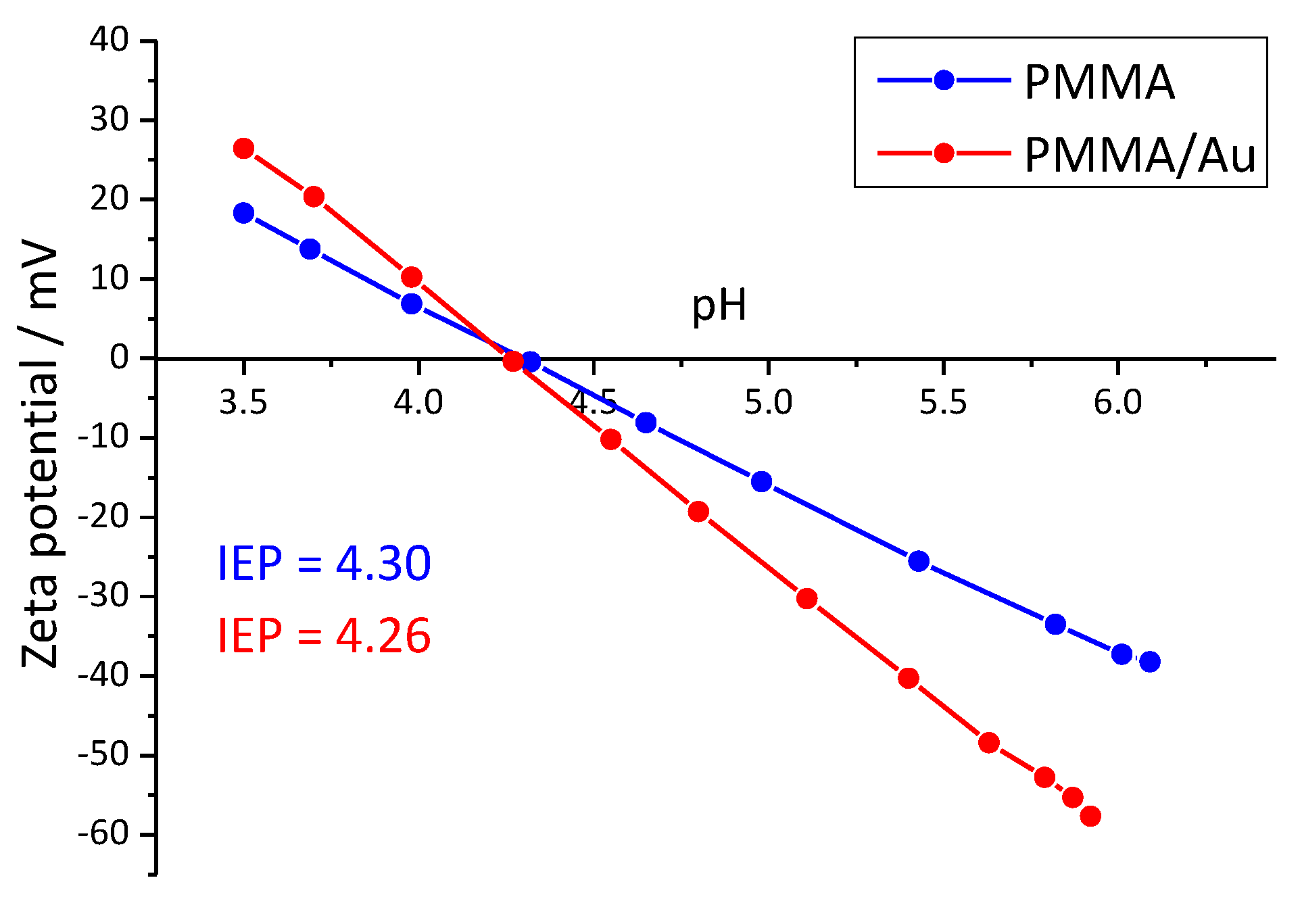
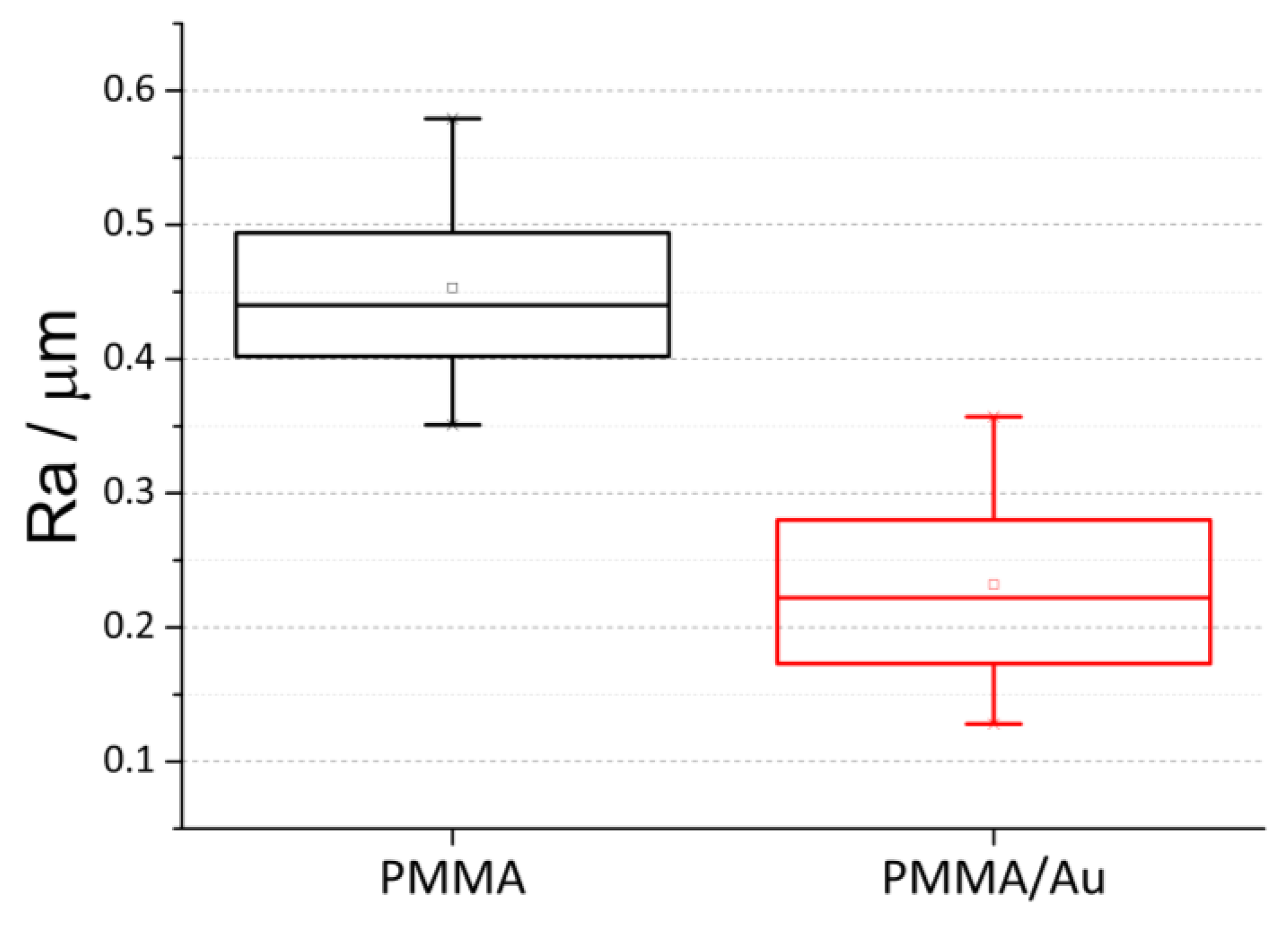
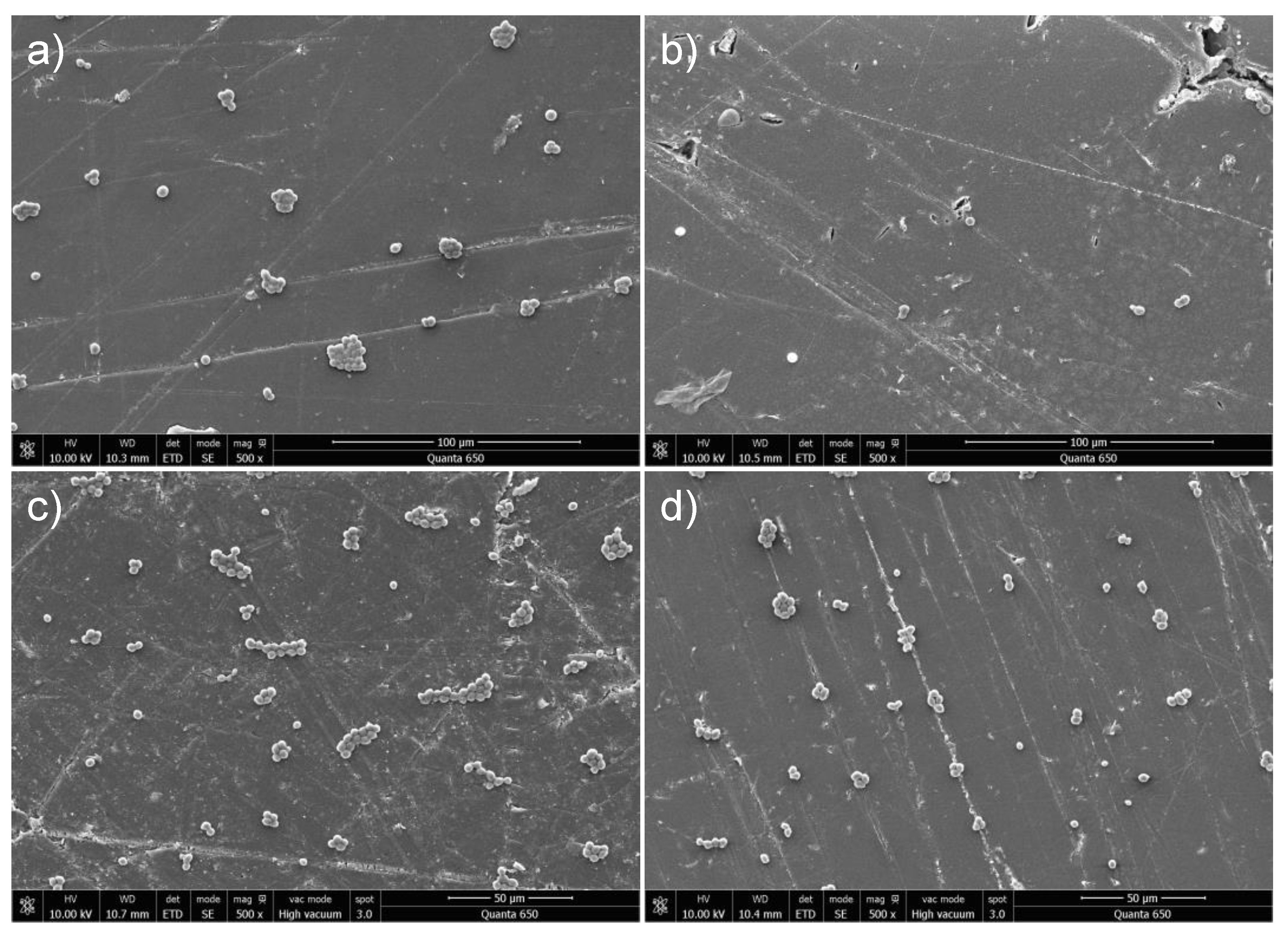
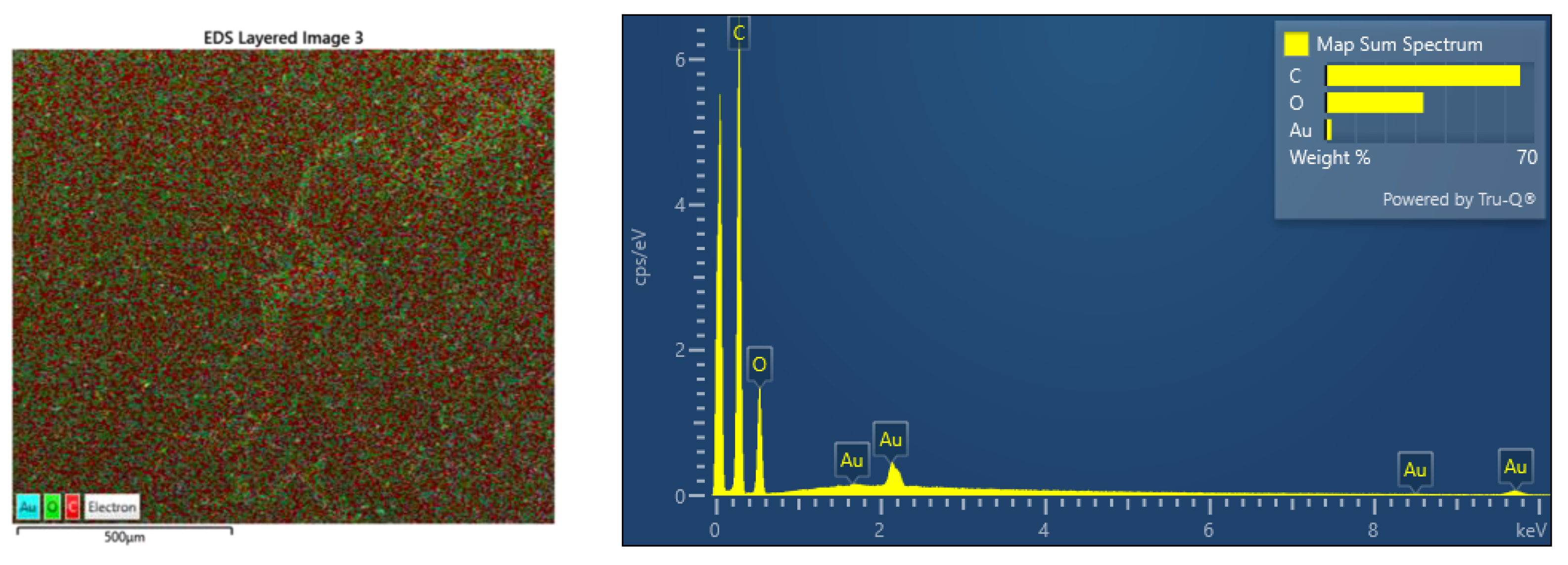
| L* | a* | b* | |
|---|---|---|---|
| PMMA | 53.82 ± 1.06 | 21.12 ± 1.09 | 12.93 ± 0.70 |
| PMMA/Au | 55.47 ± 1.46 | 19.59 ± 0.89 | 11.43 ± 0.41 |
| σM/MPa | εM/% | Shore D | |
|---|---|---|---|
| PMMA | 56.7 ± 9.5 | 3.9 ± 1.0 | 22.2 ± 0.6 |
| PMMA/Au | 34.7 ± 2.8 | 2.8 ± 0.3 | 22.7 ± 0.9 |
| 24 h | 48 h | |
|---|---|---|
| PMMA | 0.00157 ± 0.00120 | 0.00398 ± 0.00129 |
| PMMA/Au | 0.00054 ± 0.00095 | 0.00227 ± 0.00226 |
Disclaimer/Publisher’s Note: The statements, opinions and data contained in all publications are solely those of the individual author(s) and contributor(s) and not of MDPI and/or the editor(s). MDPI and/or the editor(s) disclaim responsibility for any injury to people or property resulting from any ideas, methods, instructions or products referred to in the content. |
© 2023 by the authors. Licensee MDPI, Basel, Switzerland. This article is an open access article distributed under the terms and conditions of the Creative Commons Attribution (CC BY) license (https://creativecommons.org/licenses/by/4.0/).
Share and Cite
Marić, I.; Zore, A.; Rojko, F.; Škapin, A.S.; Štukelj, R.; Učakar, A.; Vidrih, R.; Veselinović, V.; Gotić, M.; Bohinc, K. Antifungal Effect of Polymethyl Methacrylate Resin Base with Embedded Au Nanoparticles. Nanomaterials 2023, 13, 2128. https://doi.org/10.3390/nano13142128
Marić I, Zore A, Rojko F, Škapin AS, Štukelj R, Učakar A, Vidrih R, Veselinović V, Gotić M, Bohinc K. Antifungal Effect of Polymethyl Methacrylate Resin Base with Embedded Au Nanoparticles. Nanomaterials. 2023; 13(14):2128. https://doi.org/10.3390/nano13142128
Chicago/Turabian StyleMarić, Ivan, Anamarija Zore, Franc Rojko, Andrijana Sever Škapin, Roman Štukelj, Aleksander Učakar, Rajko Vidrih, Valentina Veselinović, Marijan Gotić, and Klemen Bohinc. 2023. "Antifungal Effect of Polymethyl Methacrylate Resin Base with Embedded Au Nanoparticles" Nanomaterials 13, no. 14: 2128. https://doi.org/10.3390/nano13142128
APA StyleMarić, I., Zore, A., Rojko, F., Škapin, A. S., Štukelj, R., Učakar, A., Vidrih, R., Veselinović, V., Gotić, M., & Bohinc, K. (2023). Antifungal Effect of Polymethyl Methacrylate Resin Base with Embedded Au Nanoparticles. Nanomaterials, 13(14), 2128. https://doi.org/10.3390/nano13142128








